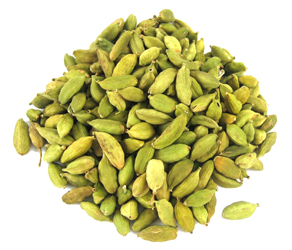Ela, Cardamom (Elettaria cardamomum)
Description of plant

Ela is pungent, aromatic, herbaceous and perennial plant in the ginger family. This plant grows in height about 2-4m. Leaves of this plant are 20-40cm long, linear-lanceolate, alternate in two ranks and have long pointed tip. Leaves are dark green and sword shaped. Flowers are produced in loose spikes about 30-60cm long and white or pale violet in color. Flowers contain both male and female parts. Fruits are 1-2cm long three sided, three chambered, yellow green pods surrounding several black and brown seeds. The green seed pods of this plant are dried and seeds are used as spice for various Indian cuisines.
General information
Cardamom is called “king of spices”. It has a strong, unique taste, resinous fragrance and extensively soothing aroma. It is almost similar to mint in its cooling system. This herb has been used as spice and medicine since the 4th century. Seeds of this plant are used in a wide range of preparations. Seeds are also added to make tea to relieve stress due to over work. It is commonly used as breath freshener. Leaves of this plant do not have aroma like seeds but they are used to wrap fishes, rice and vegetables during cooking. This herb has been traded in India for 1000 years. This herb is also mentioned in Sanskrit text from 4th century BC in Kautilya’s arthashastra where it is offered during various ceremonies. The seeds of this herb are rich in myrcene, limonene, γ-terpinene, p-cymene, terpinolene, geraniol, trans-nerolidol, heptene, linalool, camphor, citral, farnesol, and β-sitosterol.
Habitat
Cardamom is commonly native to India. It is widely found in Western Ghats of southern India. This area is known as the cardamom hills. Tropical rain forests at the elevations of 2500-5000 ft are best for its growth. By the 21st century Guatemala is the largest producer of cardamom in the world. Later it is introduced to other parts of tropical Asia and this plant is widely cultivated for its aromatic and medicinal properties of seeds. It is also found in other countries like Guatemala, Sri Lanka, New Guinea and Tanzania. It is also grown in Nepal, Vietnam, Thailand and North America.
Classification
- Kingdom – Plantae
- Order – Zingiberales
- Family – Zingiberaceae
Names
- Latin name- Elettaria cardamomum
- Hindi name – Choti elaichi
- English name – Lesser cardamom, King of spice
- Kannada name – Elakki
- Malayalam name – Elam
- Telugu name – China elakulu, Yelakkapalu
- Tamil name – Yelakka
- Marathi name – Velachi, Veldode
- Gujarati name – Elachi, Chot elach
- Arabic name – Kakul
- Farsi name – Heelabak, Elaichi khurd
Varities
On the basis of fruit size, Ela is categorised under 2 varieties, which are as follows:
- Var. major Thw.– Its fruits are large and this variety is mostly found in Sri Lanka.
- Var. minor Watt. – Its fruits are small. In India, this variety is mostly found. There are two subtypes found in India, which are as follows:
- Malabari elaichi
- Maisoori elaichi
Ayurvedic Properties
| Hindi / Sanskrit | English | ||
| Rasa | Katu, Madhur | Taste | Pungent, Sweet |
| Guna | Laghu, Ruksha | Physical Property | Light, Dry |
| Virya | Sheet | Potency | Cold |
| Vipaka | Katu | Metabolic Property (After Digestion) | Pungent |
Effects on Doshas
It pacifies kapha and pitta dosha.
| Charak Samhita | Sushrut Samhita | Vagbhata | Bhavprakash |
|
Eladi gana | Eladi, Trijatka, Charurjatka | Shwashara |
Ancient verse of Elettaria cardamomum

Sukshma, upkuchika, tutha, korangi, dravidi, truti and sukshmella are various synonyms of elettaria. It pacifies kapha dosha and it is used to cure cough, asthma, piles and painful urination. This herb has cold potency, pungent in taste, light and is used in pacification of pitta dosha.
Practical uses of Elettaria cardamomum
- Cardamom is used to cure indigestion, nausea, vomiting and used to expel phlegm out of the body. It is very beneficial in congestion of lungs and other pulmonary diseases.
- It is also used as a laxative and used to prevent stomach pain, flatulence and gripping.
- Seed oil is very good for the digestive system. It is used to relieve colic, to give warmth to the stomach and it works wonderfully in heart burn.
- Raw seeds of cardamom are chewed to detoxify caffeine and bad breath of mouth. Seeds are also used as cooking spice and to flavor various medicines.
- is used as an appetizer and this herb is also very effective in dyspepsia.
- It is used in throat related troubles, inflammation of eyelids and it is extensively used to treat infections associated with teeth and gums.
- This herb is also beneficial for the sufferers of kidney stones.
- It is analgesic and best used in the treatment of arthritis, sore muscles and lower back pain.
- It is antifungal, antibacterial and antiviral in nature and it is used against various infections.
- It is also used to reduce inflammation and is also beneficial in diarrhea.
- Seeds boiled in water to prepare tea are used to control depressio
- Cardamom seed powder mixed with amla juice acts as diuretic and is very effective in cystitis, gonorrhea and scanty urination.
- Cardamom seeds are useful for relieving sexual dysfunctions. These are used in impotence and premature ejaculation.
- Seeds with mint leaves are very beneficial for hiccups.
- It is used to pacify vata and kapha dosha.
Ayurvedic products from Elettaria cardamomum
Cautions
- Cardamom should not be given during pregnancy.
- It is not advisable for gallstone sufferers.
- Oil is not advised to people with sensitive skin.
Part used
- Fruit
- Fruit seeds
Dosage
- Seed powder – 0.5 to 1gm
- Seed oil – 2-5 drops



